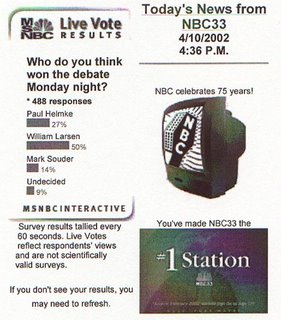Nuclear Power V Windmills
On WOWO Congressman Mark Souder recently stated that he had visited Sandia National Laboratories in NM. While there he saw solar, wind, geo thermal to name a few of the energy sources available. Souder went on to say that NE Indiana needed seven more power plants over ten years. When asked about electric cars, he was told that the electrical generating capacity is already stretched. In fact the seven power plants needed do not include any new ethanol plants as they come on line, which is said consume a large amount of electricity. Souder supports nuclear and thinks this is a large part of the infrastructure needed.
It is great to hear Congressman Souder speak out on energy, but he needs to get his facts correct. First, I worked in the Nuclear Field for ten years. I worked on fuel assemblies as well as disposing of highly radioactive waste. What Congressman Souder either does not know or has failed to mention about Nuclear power are the following;
All spent “burned” nuclear fuel assemblies are stored on site at each individual nuclear plant. A spent fuel pool was built to store the burned fuel assemblies. This spent fuel pool was designed not to hold 40 years worth of spent fuel, but far less. The reason is the DOE has been charging a fee to remove the burned fuel and store it at a national repository (Yucca Mountain). Because of decades of delay, our nation’s nuclear power plants are very fast approaching full core reserve. Full core reserve is when the total core is off loaded into the spent fuel pool and there is no space left for anymore fuel. When this happens, when full core reserve is reached, the nuclear power plant must shut down operations regardless of how much life is left in the facility.
There have been a number of nuclear power plants that have shut down before reaching their designed end of life. The utilities who have had to prematurely shut down power plants due to reaching full core reserve are now suing the DOE for breach of contract. The potential cost to utilities is in the hundreds of billions.
Therefore, to even propose constructing new nuclear power plants before you have dealt with the current nuclear waste from 105 nuclear power plants is just plain stupid and reckless. It takes more than ten years to design and build a nuclear power plant. We do not have ten years. I doubt we even have the engineering needed currenlty to do so. The engineers who once designed these facilities have moved on or retired. Keep in mind the last nuclear plant went on line nearly thirty years ago. A coal fired plant could be built in five years, but that pollutes and is a costly form of energy.
The DOE announced today that Wind-power could achieve 20% of electrical capacity by 2030. As for me, I think this is very achievable. In fact, I think we could shave 10 years off this number. A wind turbine takes three days to erect. If you were to replace a nuclear plants' capacity with windmills, you would need about 300to 400 windmills. What do you think is easier to get permits for, Nuclear or windmills?
Department of Energy Says 20% Wind Power Achievable
7:00 AM EDT May 23, 2008
WASHINGTON, May 23 /PRNewswire/ -- The U.S. Department of Energy (DOE) has released a ground-breaking report concluding that using wind power to generate 20 percent of the nation's electricity is achievable -- without any new technological breakthroughs. The DOE's report "20% Wind Energy by 2030" stated that by accelerating the growth of wind power the nation's consumption of natural gas could be reduced by 11 percent and consumption of coal by 18 percent annually -- providing a reduction of 825 tons of carbon dioxide emissions linked to global warming every year.
"This is the equivalent of taking 140 million cars off the road," said Randall Swisher, of the American Wind Energy Association.
"We can do this nationally for less than half a cent per kilowatt hour if we have the vision," said Andrew Karsner, the DOE's assistant secretary for efficiency and renewable energy.
According to the DOE's report, the growth rate needed to reach 20% would pose challenges for the wind energy industry but is achievable. Already, the wind industry is attracting many new entrants -- traditional utilities like Florida Power and Light (NYSE: FPL), smaller wind developers and even big oil companies.
On Monday, legendary oil man T Boone Pickens placed a $2 Billion order for wind turbines from GE (NYSE: GE). Pickens is among many in the oil and gas industry that are investing heavily in wind. "It's time for America to change the way we think about wind power," said Bob Lukefahr of BP North America (NYSE: BP). Both BP and rival Shell (NYSE: RDS.A) are major players in the wind energy space.
Smaller wind companies are also thriving. This week Nacel Energy (OTC Bulletin Board: NCEN), a Wyoming headquartered wind developer, announced a 600 MW joint-venture wind project. CNBC guest analyst Francis Gaskins was first to cover Nacel Energy when it IPO'd last year -- and analysts at Advisory Research have published a new higher $5.03 price target on the Company.



0 Comments:
Post a Comment
<< Home